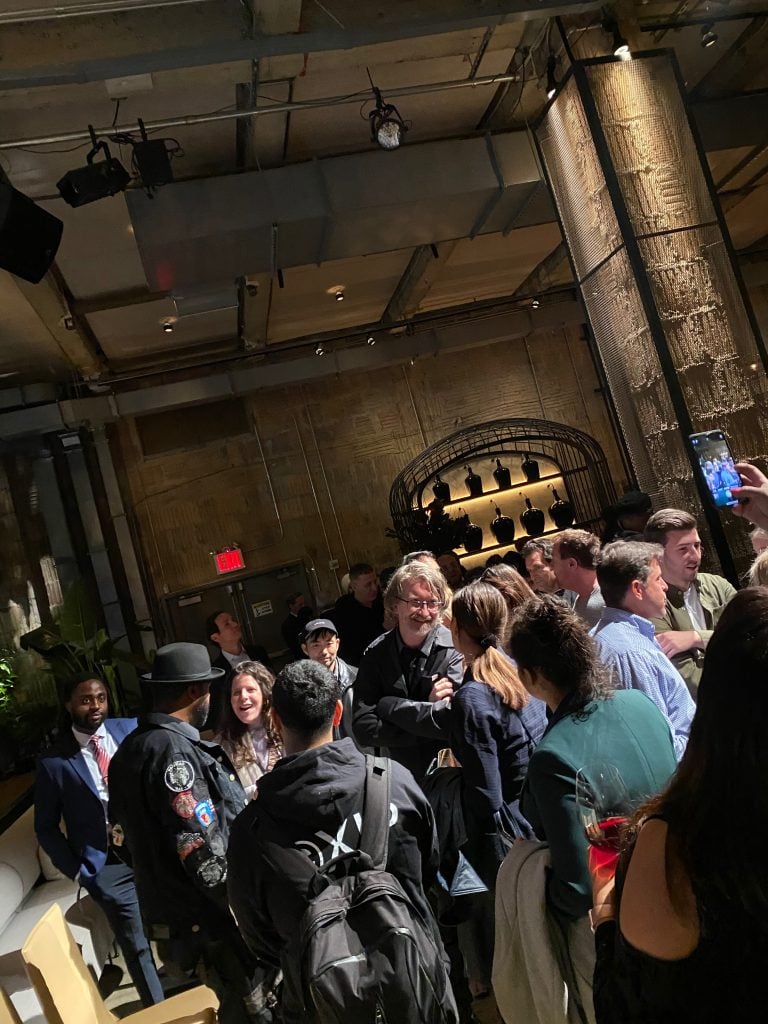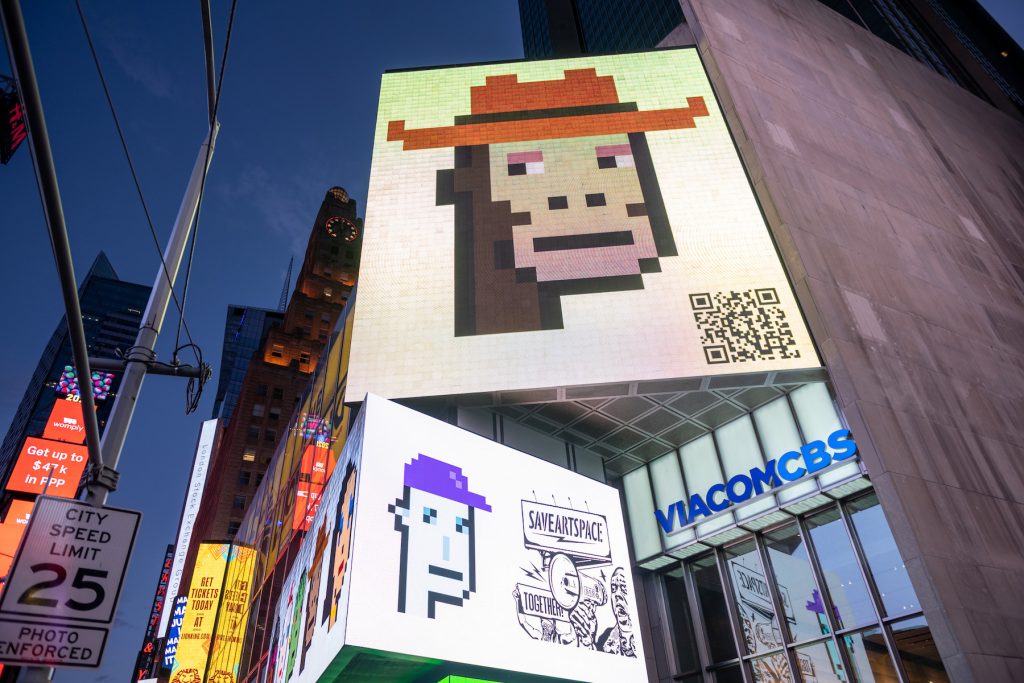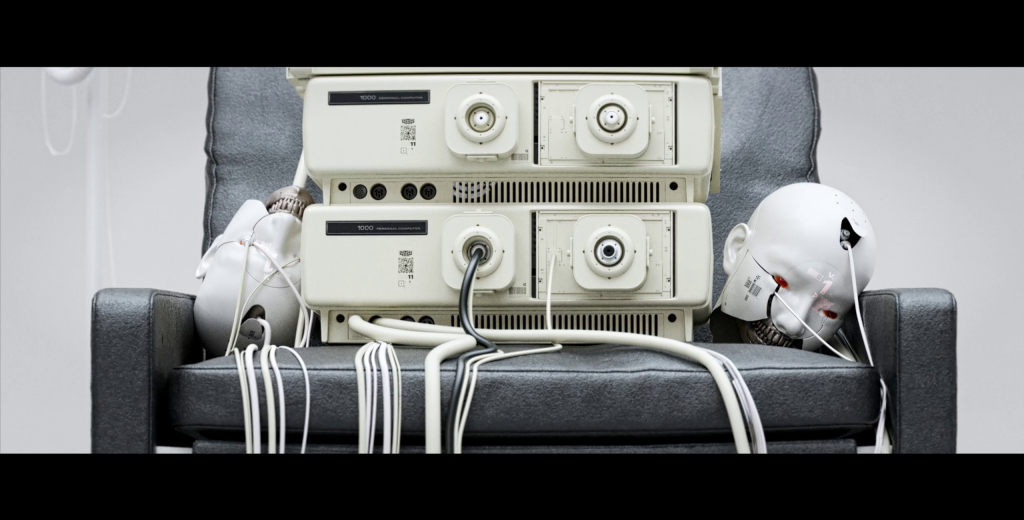The Gray Market
4 Ways the Crypto Space Is Splintering From the Art World, as Seen at This Week’s Blockbuster NFT Conference (and Other Insights)
Our columnist visits NFT.NYC and finds some surprising thoughts on art future in the crypto space.

Our columnist visits NFT.NYC and finds some surprising thoughts on art future in the crypto space.

Tim Schneider

Every Wednesday morning, Artnet News brings you The Gray Market. The column decodes important stories from the previous week—and offers unparalleled insight into the inner workings of the art industry in the process.
This week, navigating an alternate reality…
Imagine that today, you, a keen art world observer, run into a like mind who you generally trust on the streets of New York, and whose absolute serenity could not feel like more of a contrast to the driveshaft of go-go-go anxiety propelling your exhausted mind and body forward.
They ask how you’re doing, and you say, “Oh fine, you know how it is when you’re on your second or third day racing from event to event—the talks, the openings, the drinks, the networking. Basically just one more big art fair week in a weird season that was already too full of them!”
Your friend looks at you kindly but slightly strangely, as if you just picked a french fry off the sidewalk and popped it into your mouth mid-answer. You know what they’re thinking: “A big art fair week in New York? Sure, the industry calendar has been full of makeup events jammed into all kinds of weird slots lately. But there are no art fairs at all in New York this week, let alone any major ones. What is this person talking about?”
This is a faithful recap of an experience I had this Tuesday, and it happened because there was one crucial difference between my half confused, half concerned acquaintance and me: I’m continuing my imperfect but good-faith effort to keep up with NFTs, and it would be cognitively impossible for my counterpart to care about NFTs any less than they do.
The result? They, like nearly all of my perpetually plugged-in colleagues at Artnet News, were completely unaware that this week is NFT.NYC.
For those of you in the same category as my acquaintance, NFT.NYC is a gargantuan three-day crypto conference and networking bonanza headquartered in and around Times Square. The official program includes 542 (not a typo!) approved speakers appearing on multiple stages in front of throngs of attendees. And, as in a big art fair week, a vast array of satellite events have been launched to orbit the NFT.NYC mothership, creating dozens more related opportunities to explore and indulge the main themes.
I’ve done my best to hop around as many of those satellite events as possible. (Demand for this year’s sold-out edition of NFT.NYC was so high even among media members that Artnet News was allowed only two non-transferable press passes.) Shortly after I started mapping out my schedule for the week, I began to feel like I had unwittingly stepped through a trap door into a passageway accessible from the art world but not wholly part of the art structure.
That feeling only amplified in the following days. At a packed-house event on Monday staged by his NFT platform, Monegraph, artist and NFT co-inventor Kevin McCoy agreed that this week’s crypto mega-confab was “a parallel universe” to the art world. After conversations with McCoy and other people navigating the tunnel between crypto and visual art with even greater commitment than me, the experience of NFT.NYC has led me to a few conclusions about the art businesses’s current relationship to NFTs and the larger crypto space.
(As far as I can tell, the phrase “the crypto space” has become the equivalent of “the art world” for blockchain believers: the preferred verbiage to sublimate the infinite nuances of a complex subculture and industry into a casual catch-all that won’t force fellow travelers to slow down their conversations to define basic terms.)

Images of CryptoPunks displayed on a digital billboard in Times Square on May 12, 2021 in New York City. (Photo by Alexi Rosenfeld/Getty Images)
The biggest sales headlines still belong to artists like Beeple and series like CryptoPunks. But even the quickest skim through the session titles at NFT.NYC corrects any sense that visual art is still the center of the NFT universe. Panel topics at this edition of the conference include NFTs’ impact on music, gaming, sports, finance, social media, standup comedy, whiskey, ocean conservation, women’s health, and more.
Art’s increasingly complementary role to the space comes into even clearer focus courtesy of the mainstream star power that arrived this week from other cultural sectors. Quentin Tarantino made a surprise appearance onstage at NFT.NYC on Tuesday to reveal that he will tokenize his handwritten screenplay for Pulp Fiction. Monegraph based its two big NFT.NYC week events around crypto projects with music star/superproducer Timbaland and Wu-Tang Clan member Mathematics.
When I asked McCoy what we should read into this choice given his art career (primarily as a duo with his wife, Jennifer), he nodded to NFTs’ appeal to a vastly larger audience.
“The art world is a great world, and it welcomes several types of people. But crypto welcomes everybody,” he said, underscoring the point by estimating that he saw approximately 700 people lined up for pre-registration at NFT.NYC earlier in the day.
“People ask, did I think about this back in 2014? And I did think tokenization would change the world of media, but the lived reality of it, the people, the crowds… I never imagined that part.”
The question is how many of these non-art crypto initiates will convert into NFT art collectors. Xin Li-Cohen, the non-executive deputy chair of Christie’s and the chair of the recently launched NFT platform TR Lab, is optimistic.
“We’re still in the infancy of this revolution,” she said. “We believe that each project, whether it be an art NFT work, or a PFP, or a gaming collectible, will keep bringing different people into the space.”
I should postscript that header by emphasizing that a subset of crypto-artists never cared about being accepted by the art world, but contentment with NFTs’ independence from the industry’s pre-existing structures definitely seems to be escalating.
“I feel like NFT people are just tired of waiting for someone else to validate the subculture,” said Olive Allen, a fast-rising young multimedia artist curated into Galerie Nagel Draxler’s recent NFT exhibitions (both in the gallery and at Art Basel) by my colleague and crypto-artist Kenny Schachter.
“I might as well connect with likeminded people and say, ‘Fuck it, let’s do it ourselves.’ That’s very in line with what this new generation believes in,” she said.
It’s also worth emphasizing that Allen’s portrayal of this collaborative community primarily concerns the artistic subculture within the broader NFT space. She likened some of what’s happening in the technology to a kind of digital gentrification; instead of artists serving as an unwitting shock force for real-estate developers by providing an anchor that can start to make a cheaper neighborhood seem cool to mainstream renters, artists created and built a community around NFTs only to see (often, to their chagrin) other industries start piling in for bald commercial gain.
Allen described this crypto-capitalist attitude toward her and her peers as, “Thanks artists, now go away! It’s time for big bros to do big business!” This weird energy is just one more reason that more and more artists, collectors, and connectors who believe in NFTs are inclined to focus on creating their own structures with their own community of true believers than to seek outside approval from anyone in any other space, including the old-school art world.

Artist Olive Allen with her NFT work Post-Death or the Null Address (2021) in Galerie Nagel Draxler’s booth at Art Basel 2021. Courtesy Olive Allen.
Look, I know some of you are rolling your eyes. I get it! It sounds preposterous to talk about building an eternal creative legacy through the same apparatus that allows internet celebrities like Gary Vaynerchuk to run up millions hawking digital assets linked to animals he doodled with magic markers and stuck an alliterative adjective in front of.
Still, let’s not make the mistake of painting all humans engaged with NFT-connected art as the same. It’s not as if there aren’t plenty of reasons to be embarrassed about the amounts paid for some traditional artworks. Forget about the Bored Ape Yacht Club; people have shelled out thousands of dollars for paintings by actual chimps!
“What we will need for the markets to continue to grow is more fine-art projects curated around compelling ideas and experiences,”said Li-Cohen, whose TR Lab has sold NFTs works by Cai Guo-Qiang and is currently in the midst of a series of drops of generative NFT works inspired by the sci-fi story collection A.I. 2041. “These are the projects that create the lasting value that collectors are looking for.”
Allen is another example of a thoughtful, serious counterweight to the nonsense. Her practice has always incorporated more than just NFT-connected art or digital art. She’s preparing a solo show in New York right now that will incorporate multiple physical mixed-media pieces. However, she stressed that NFTs “will always be a component of all of [her] work,” because tokenizing a piece is what will ensure that it can be displayed in the metaverse.
Now, this is a big, mind-warping idea, especially for art traditionalists who may currently only associate the metaverse with either Sotheby’s newly launched NFT marketplace platform or Facebook’s depressing virtual office software and new official corporate moniker. But I’ll try to summarize the most important parts…
Think of the metaverse as a fully immersive virtual world where many of us will spend much of our personal and professional time. This also means that many of the same social and psychological dynamics we live with now will be ported over to the metaverse. Which also means art collectors will want their art collections—including the physical pieces—to be a seamlessly integrated part of the metaverse. After all, they find enrichment in looking at the works, and they can communicate important information about their interests, knowledge, and/or net worth by exhibiting those works to others. Both sides of that coin are still important if you’re spending a big chunk of your existence inside a digital world.
In this situation, collectors in the metaverse will need some kind of mechanism to prove that the works they’re displaying are the genuine article. NFTs are the obvious solution. So even if you’re an artist making paintings or sculptures or Turbine Hall-filling environmental installations, those tangible works can only live on forever in an immersive digital world if they are tokenized. And living on forever inside the cradle of culture is the goal almost all artists have been chasing since the first human splashed paint on a cave wall.
“This is just the new dimension of chasing immortality,” Allen said. “Because let’s face it, immersive reality sucks. In the metaverse, there are no restrictions on time. Gravity doesn’t even exist. Nothing is impossible, while the physical realm has its limitations.”

Ash Thorp, Evident Mirror (2021). Courtesy Ash Thorp for TR Lab.
To be clear, this blast of dystopian existentialism is my between-the-lines reading of the crypto community’s outsized enthusiasm for NFTs and its smaller criticisms about opposing forces, all set amid the larger context of life in 2021. But I think it’s real.
True, either a techno-utopian or a techno-anarchist mindset drives the development of many (if not most) new technologies, and blockchain as a whole falls into the latter category to me. Remember, the animating idea was to establish decentralized, “trustless” networks as an alternative to systems governed by central authorities—and thus, vulnerable to those authorities’ many failings. Although the Great Financial Crisis of 2008 was not its direct trigger, the Bitcoin white paper was developed out of longer-running concerns about the modern banking system’s instability.
However, technologies woven from techno-anarchist fabric tend to have their hard creases ironed out as they get closer and closer to mainstream adoption and everyday use. I don’t feel like that’s happening with NFTs.
The many references to a belief in “democratizing the art/music/entertainment/whatever world” that I heard during multiple days’ worth of events also hit different in a country where 50 million people think the last presidential election was stolen, and Congress’s approval rating hasn’t surpassed 39 percent in 15 years, according to Gallup. Large bipartisan majorities of voters support expanding healthcare, lowering prescription drug costs, and raising taxes on the very wealthy, yet not even a simple majority of federal lawmakers can be found to implement any of the above.
The labor market remains awful too, especially for young people, and especially within the art world. If that wasn’t enough, ecological Armageddon looms over all of us, while the most powerful leaders in the world largely grind their gears on major green initiatives. Is it any wonder amid all this chaos that thousands of people looking for some reason to hope could converge with evangelical fervor on a technology with a D.I.Y. ethos, a community spirit, and a rich vein of capital to tap?
McCoy said it best: “In the crypto world now, everybody feels like they’re building the future.” No matter what you think of NFTs or the art most commonly associated with them so far (I’ve certainly been critical of both), we should take notice of the fact that vanishingly few people would say the same about the traditional art world at this point—or, for that matter, much else.
That’s all for this week. ‘Til next time, remember: every space contains multitudes.